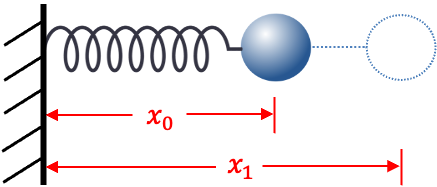A harmonic oscillator comprises a particle that is subject to a restoring force proportional to the particle’s displacment from its equilibrium position.

Consider a mass connected to a rigid support by a massless and frictionless spring (see above diagram). At equilibrium, the length of the spring is
. Let’s assume that the only force
acting on the mass is a restoring force that is directly proportional to the displacement of the mass (Hooke’s law):
where is the displacement of the mass from its equilibrium position and
is constant of proportionality called the force constant.

Question
Explain why is a measure of the stiffness of the spring.
Answer
For a particular value of , the stiffer the spring, the less the mass displaces. Since
is inversely proportional to
, it is a measure of the stiffness of the spring.
Substituting the equation for Newton’s 2nd law of motion in eq1, we have
The solution to the above differential equation is , where
. As the displacement of the mass is defined by a wave equation, the system is called a harmonic oscillator (‘harmonic’ originates from sound waves). The mass oscillates with amplitude
and frequency
(see Q&A below), and the kinetic energy
and potential energy
of the system are

Question
Explain why the mass oscillates with a frequency of and why the potential energy of the system is equal to
?
Answer
Since , the function repeats itself after a time
. This implies that the period
of the motion of the mass is
and that the oscillation frequency
is
.
The force exerted by a person in lifting an object over a distance
against gravity is
, where
is the work done by the person.
must also be the amount of potential energy the object gains, i.e.
. Furthermore, the force exerted by gravity
is opposite to the force exerted by the person. So,
and for small changes,
. Since gravitational force and elastic spring force are both conservative forces (work done is path-independent), we substitute eq1 in
to give
. Therefore, the potential energy of a harmonic oscillator is
.
The total energy of the harmonic oscillator is
and the Hamiltonian , which is the sum of the kinetic and potential energies of the oscillator can be expressed as
Before we show how the harmonic oscillator can be used to model a vibrating diatomic molecule, we shall look at the quantum-mechanical treatment of a harmonic oscillator.